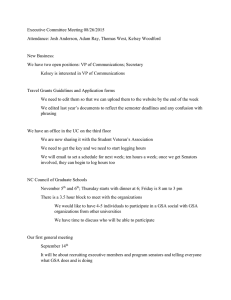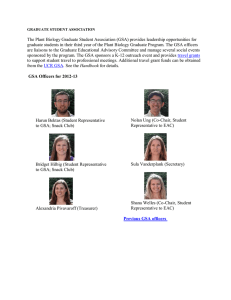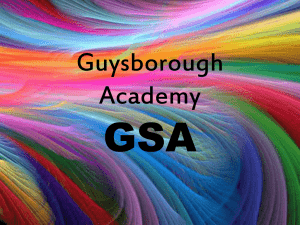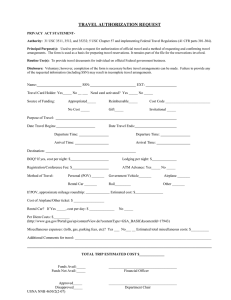Council Members,
advertisement
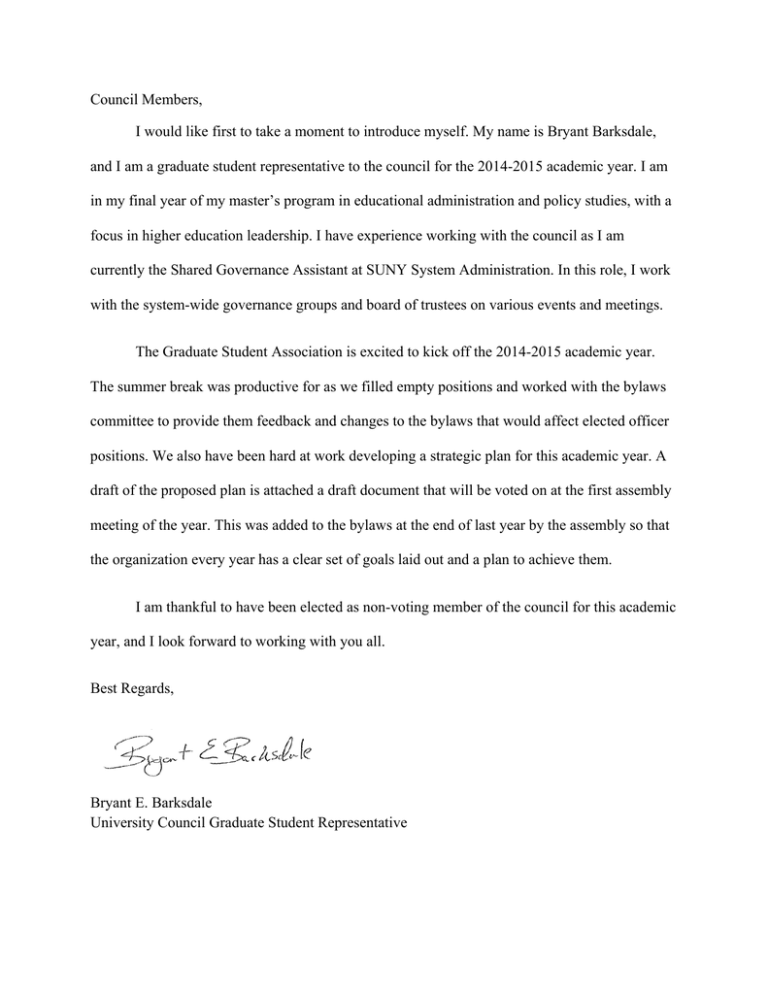
Council Members, I would like first to take a moment to introduce myself. My name is Bryant Barksdale, and I am a graduate student representative to the council for the 2014-2015 academic year. I am in my final year of my master’s program in educational administration and policy studies, with a focus in higher education leadership. I have experience working with the council as I am currently the Shared Governance Assistant at SUNY System Administration. In this role, I work with the system-wide governance groups and board of trustees on various events and meetings. The Graduate Student Association is excited to kick off the 2014-2015 academic year. The summer break was productive for as we filled empty positions and worked with the bylaws committee to provide them feedback and changes to the bylaws that would affect elected officer positions. We also have been hard at work developing a strategic plan for this academic year. A draft of the proposed plan is attached a draft document that will be voted on at the first assembly meeting of the year. This was added to the bylaws at the end of last year by the assembly so that the organization every year has a clear set of goals laid out and a plan to achieve them. I am thankful to have been elected as non-voting member of the council for this academic year, and I look forward to working with you all. Best Regards, Bryant E. Barksdale University Council Graduate Student Representative Graduate Student Association University at Albany/SUNY, Campus Center 307 & 308, Albany New York, 12222 Strategic Plan 2014-2015 Last Revised July 30, 2014 EXECUTIVE SUMMARY The 2014 Executive Board for the Graduate Student Association (GSA) herby proposes a strategic designed to inform the Assembly of Executive Board intent for the upcoming academic year, and to attest as to how the Executive Board intends to proactively facilitate the mission statement of the GSA. This strategic plan based upon three branches: (1) advocacy, (2) professional development, and (3) service, as they relate to the graduate student population at the University at Albany/SUNY. This proposal is submitted to the Assembly as an outline of objectives, assessments, and resources needed to satisfy Executive action. While reading this document, the Assembly is encouraged to consider how they want student activity fee monies used to facilitate this organization. All members of the Assembly with questions, comments, are encouraged to attend the first assembly meeting of this academic term [INSERT DATE AND LOCATION] to voice their comments for further discussion. Note that this plan is not intended to circumvent GSA bylaws, but rather designed to allow the flexibility required to carry out advanced plans which may otherwise not fit into a specific job description. This allows the Assembly as a whole to actively participate in any portion of GSA activity which is of interest to them. As the MCAA Chair, I have carefully reviewed the objectives within this document, and approve its contents and objectives. It is my personal belief that meeting these objectives are essential to the future of this organization, as they are aligned with promoting the core values of the GSA. I welcome discussion and suggestions pertaining to all aspects of this strategic plan. Amani Edwards, [INSERT SIGNATURE] GSA MCAA Chair ADVOCACY VISION STATEMENT In order to promote GSA advocacy, we hope to solidify relationships with key offices within the SUNY System. By continuing to foster the relationships with offices such as the Office of Environmental Sustainability, the United University Professions, the Graduate Student Employees Union, the SUNY Albany University Senate, the National Association of GraduateProfessional Students, and the SUNY Student Assembly, we will shift the spotlight onto the GSA at both a system and national level. In addition to expanding present relationships, we will look at laying the foundation for cooperation with other organizations on campus, such as University Auxiliary Services, Graduate Studies, ITLAL, Career Services, Financial Services, and Library Services, to name a few. Critical to the advocacy agenda is the re-conceptualization and re-building of the Multicultural and Affirmative Action Chair position. We hope to revitalize this position, while nurturing our network all in efforts to support values which have historically been central for student governments. One of the mechanisms on campus that may help us achieve these goals include critical participation on the Community/Public Engagement committee since it is one of the four stakes in the ground proposed by President Jones. Finally, this year the GSA seeks to build its institutional memory and its structural capabilities to end its long period of isolation. We are the graduate student government of a state University and we are only a few miles from the central governance of this system. It is not just our location, but the vision and mission of our new President that requires we prepare ourselves to facilitate our own inclusion in a much broader sense. We need to have a meaningful role in steering the future of this institution within the community and within the SUNY system. It is the primary goal of the GSA President to facilitate this institutional memory and develop the mechanisms we need to sustain a strong student government which can continually build and exercise its voice. Caitlin Janiszewski, [INSERT SIGNATURE] GSA President PROFESSIONAL DEVELOPMENT VISION STATEMENT The GSA’s professional development strategic plan will consist of three pillars: 1. academic and non-academic professional development events, 2. consolidating and communicating university professional development resources, and 3. outreach to improve professional development opportunities. There are many mechanisms through which we will work on graduate student professional development. For professional development events, we will work on sponsoring events such as a GSA Research Conference, CV and Resume Workshops for academic and non-academic jobs and internships, and possibly a panel to discuss how to apply your degree to non-academic jobs. Creating a professional development resources page for graduate students to more easily find professional development opportunities by consolidating many university and community networks and resources in addition to creating more. And finally reaching out into the community to improve databases of professional development opportunities. Kat Syle, [INSERT SIGNATURE] GSA Vice President President’s Agenda: AdvocacyGoal # 1: Solidify and/or build our relationships with key entities on campus Facilitate the production of our newsletter “The Purple Paper” which publishes information from financial services, GSEU, UUP, library services, etc. as well as articles about our University community. Redesign our new office spaces to reflect a stronger relationship with our network: i.e. Sustainability corner (with info about riding CDTA free, etc.) and Labor Lane (which might just be a bulletin along the wall with the latest on the GTA contracts) For example, we can engage our programming and legislative agendas to back up our partner’s goals and objectives: Environmental Literacy, and Financial Literacy, Labor Awareness, etc. Example: we are going to work with the UAS board rep to reduce plastic use on campus, promote a Fair Trade Agenda, and then use our position in the Senate to promote sustainability values within academic culture, not just in institutional operations. Other partners may have a more limited agenda through which space in our newsletter and on our listserv may suffice. Others we may take a more active role with. Develop a mechanism for using Assembly input for Senate activities such as nominating faculty for search committees. Goal # 2: GSA vote or die – to get at least 10% of the graduate student population to vote in our elections next year Reforming our office spaces, improving our newsletter, and continuing to grow our relationships with other entities on campus obviously contribute in an indirect way to this goal. Develop an identity for the Downtown GSA office. Replace the GSA picnic with a multiple day orientation. Represent issues people care about in our positions of power – in the Senate, on University Committees, etc. Reaching out to students it only a first step, representing their interests or proving an organizations efficacy are key to retaining people. Pool programming money into fewer bigger events to make ourselves visible. Develop a targeted communications agenda – blast emails can only do so much. Goal # 3: Establish the garner respect for GSA’s critical position in the University Community, Capital Region and the SUNY System. Continue to serve on CNSE transition committee Serve on Public Engagement Committee – find grad student place in cycle of reciprocity with the community. Facilitate student input for the hiring of the new Provost President’s Forum Serve on Governance Council Senate Executive Committee Ban the Box Campaign – University Senate and SUNY SA Contingent Faculty Resolution – University Senate Professional DevelopmentGoal # 1: Develop a hybrid academic / non-academic professional development model which empowers students to accommodate the shifting job market Promote non-academic professional development opportunities under the umbrella of community engagement Help the Public Engagement committee come up with a mechanism for assessing graduate student contribution to the community. Use my position at NAGPS as National Employment Concerns Chair to help develop a job bank, and employment concerns matrix, and find new leads on how to approach the graduate student jobs crisis. _[INSERT SIGNATURE] Vice President’s Agenda: AdvocacyGoal #1: Improve relationship with faculty Redevelop the faculty advisor relationship statement for RGSOs. o Formally consult the three parties implicated; RGSO leadership, Office of Student Involvement, and the faculty (via the Senate). Professional DevelopmentGoal #1: RGSO reform Implement new and improved RGSO guidelines to establish a fresh vision for RGSO activity. o Easier reimbursement process o Clarified application process and service requirement Work with the GSA Treasurer, UAS, and our Campus Designee to facilitate more direct payment options. Assess effectiveness of RGSO binders and made necessary adjustments. Improve RGSO training Goal #2: Develop a hybrid academic / non-academic professional development model which empowers students to accommodate the shifting job market Work with the GSA President and Career Services to develop a network of potential employers and partners from the region (i.e. actual employers or the local Chamber of Commerce offices, State Agencies, Department of Labor etc.). Hold a GSA Research Conference: o Include purely academic component such as panel presentations o Include alternative formats such as a job fair or poster session geared towards non-academic employment. Ensure that the RGSO faculty relationship statement reflects the prioritization of this hybrid model. ServiceGoal #1: Contribute to our efforts to better communicate with our student body Work with the IT consultant to develop a GSA app for Apple and Android smart phones. [INSERT SIGNATURE] Treasurer’s Agenda: Advocacy / Professional DevelopmentGoal #1: Develop sound fiscal policy for the GSA Adopt proposed fiscal guidelines Evaluate operation costs Evaluate the use of non-operational costs (programming money, large investments, etc.) Research best practices for non-profit and student government spending (ex. Determine how much should be discretionary funding, how much should be based on specific proposals, how much should go to individuals vs. RGSOs, etc.) Establish a handbook for future internal controls based on these assessments Look into the possibility of GSA fundraising Goal # 2: Increase the efficiency of our financial operations Adopt new proposed RGSO and fiscal guidelines Work with UAS to develop as many direct payment options as possible Assess UAS contract and advocate for appropriate amendments Develop mechanism to improve efficiency of our online reimbursement process (use less paper, take less time, etc.) Review and revise GSA independent contractor form Goal # 3: Assess the strategic plan Play a leading role in assessing our first round of strategic plans [INSERT SIGNATURE] MCAA Agenda: AdvocacyGoal #1: Comprehensive reform the MCAA position Change the name to the “Equity and Inclusion Chair” via a constitutional amendment. Pass the E-Board section of the bylaws proposed by the E-Board that refers to the role of the MCAA chair Execute the new responsibilities listed and assess the effectiveness of the new roles Goal # 2: Outreach and programming to support GSA marketing efforts and promote issues of diversity, equity, and inclusion throughout all aspects of GSA operations Outreach to international student via ISSS (Thanksgiving Dinner) Outreach and support to cultural RGSOs to improve programming for important cultural/spiritual holidays Outreach to departments which focus on issues of diversity and inclusion Support the Ban the Box campaign Sit on the President’s Diversity Council Possible speakers: o Preacher Moss – funny and insightful o Tim Wise – funny, insightful, expensive o Black Jew Dialogues – amazing, not sure if they are still touring [INSERT SIGNATURE] Programming Agenda: Advocacy / Professional Development / Service Agenda – Goal # 1: Market the existence of the GSA Support Vice President in effort to hold a University-wide GSA research conference GSA Orientation Program in lieu of a traditional picnic to attract students to our new offices and offer them critical information Daily Programming to make good use of our extra space: Music Mondays, Tea Tuesdays, etc. Put our name on well planned programming executed by our partners o Bill McKibben (Sustainability) o Thanksgiving Dinner (ISSS) Support and help facilitate the MCAA chair’s programming agenda Pool monies (or allocate a special line with an assembly vote) to bring a speaker to campus which will draw a large crowd. Options include: - Sarah Kay, Poet - Avery Brooks, Poetry - Patrick Stewart, Amnesty International - Bryan Stevenson, Equal Justice Initiative (as part of Ban the Box) - George Takei, Equal Rights - Ken Robinson, Modern Education and Creativity - Chimananda Ngozi Adichie, Culture of Storytelling - Luis von Ahn, Re-purposing the internet - Freeman Hrabowski, under represented students in academia - Patrick Awuah, Importance of liberal arts - Christopher Emdin, Making classrooms come alive Goal # 2: Retention of student participation in the GSA Hold a Q&A each year before GSA elections to share information with students interested so they can see that these positions are fruitful for personal, professional, and leadership development as well as great for networking. Develop a mentor program to serve students but also serve GSA retention Hold a student rep mixer to bring RGSO, Senate, council reps, etc. together Goal # 3: Support the GSA advocacy agenda Plan and execute a President’s Forum in the Fall and Spring Guerilla programming (ad hoc, simple, focused) to support Ban the Box, Faculty Resolution, etc. [INSERT SIGNATURE] Grants Agenda: Professional DevelopmentGoal #1: Continue to develop the GSA Grants Program compare to old process as well as from new people to see how easy Survey student body for feedback on grants program Research best practices for grants programs (allocation models, percentage of budgets, evaluation criteria, categories of professional development) Amend grants guidelines or process according to feedback and research ServiceGoal #1: Communication of resources Develop resource page on the GSA website (links to state internships, Chamber of commerce, funding information, academic and non-academic resources) Work with President, VP, and appropriate University entities to organize this page. Work with E-Board to develop a critical communication strategy (through social media, orientation, newsletter) to make sure the resources we collect are communicated to students. [INSERT SIGNATURE] Legislative Agenda: AdvocacyGoal # 1: Work to change the culture of the University Senate by executing an aggressive agenda which addresses critical issues of shared governance. Ban the Box Campaign - equal access to higher education (both SUNY SA and University Senate) Contingent Faculty Resolution Consult the faculty regarding RGSO advisers Follow up on a UPPC resolution from 2008 regarding Sustainability at UAlbany Address residency issues for graduate students (all students) on GAC and UAC Help facilitate an opportunity for the Office of Sustainability to report to the Senate Goal # 2: Establish GSA Senators as a critical voice for graduate students in the University Senate and the SUNY system Take the Ban the Box campaign to the SUNY SA Actively engage with the public components of the Provost search Establish an identity for the Downtown GSA office as an advocacy office Proactively engage components of President Jones’ new vision for UA by voicing our concerns regarding: o The development of Downtown Schuyler Building o Building of a College of Science and Engineering (soliciting input and raising concerns in relevant Senate councils, both from students in existing Science departments, as well as community partners affected such as Albany Medical Center) o Introduction of SUNY2020 R&D Clusters (assessing the use of native talent and assuring funding opportunities for existing students studying related topics in core departments) o Community Engagement agenda [INSERT SIGNATURE]
